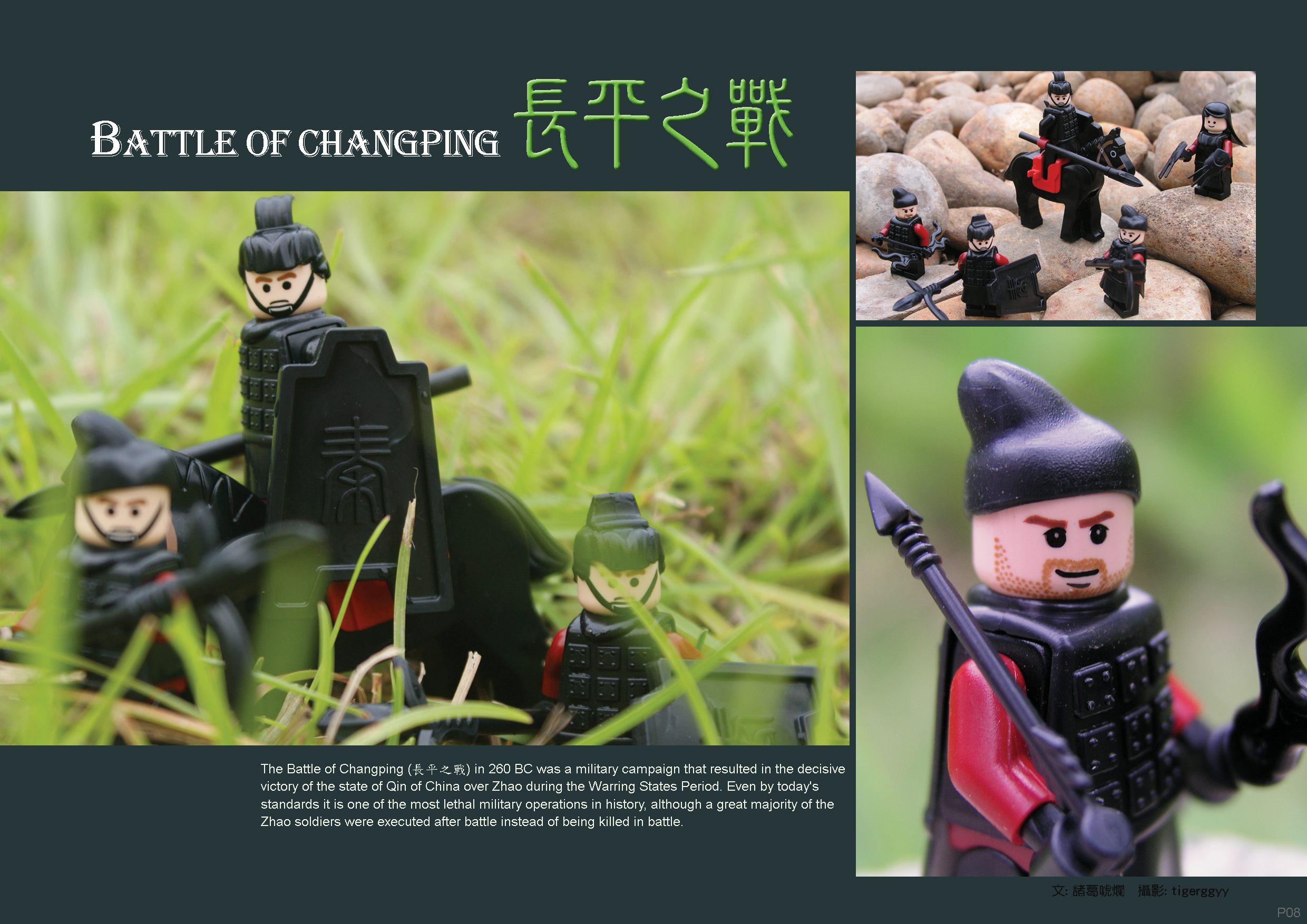[樂高 中國歷史] Qin Dynasty 秦朝

The Qin Dynasty was the first ruling dynasty of Imperial China, lasting from 221 to 206 BC. The Qin state derived its name from its heartland of Qin, in modern-day Shaanxi. The Qin's strength had been consolidated by Lord Shang Yang in the 4th century BC, during the Warring States Period. In the early third century BC, the Qin accomplished a series of swift conquests; the state subjugated the Chu, remnants of the Zhou Dynasty, and various other states to gain undisputed control of China.
During its reign over China, the Qin Dynasty achieved increased trade, improved agriculture, and military security. This was due to the abolition of landowning lords, to whom peasants had formerly held allegiance. The central government now had direct control of the masses, giving it access to a much larger workforce. This allowed for the construction of ambitious projects, such as a wall on the northern border, now known as the Great Wall of China.
The Qin Dynasty also introduced several reforms: currency, weights and measures were standardized, and a better system of writing was established. An attempt to purge all traces of the old dynasties led to the infamous burning of books and burying of scholars incident, which has been criticized greatly by subsequent scholars. The Qin's military was also revolutionary in that it used the most recently developed weaponry, transportation, and tactics, though the government was heavy-handed and bureaucratic.
Despite its military strength, the Qin Dynasty did not last long. When the first emperor died in 210 BC, his son was placed on the throne by two of the previous emperor's advisers, in an attempt to influence and control the administration of the entire country through him. The advisors squabbled among themselves, however, which resulted in both their deaths and that of the second Qin emperor. Popular revolt broke out a few years later, and the weakened empire soon fell to a Chu lieutenant, who went on to found the Han Dynasty.[note 1] Despite its rapid end, the Qin Dynasty influenced future Chinese regimes, particularly the Han, and from it is derived the European name for China.
秦朝(前221年—前207年),是由戰國時代後期的秦國發展起來的統一大國。秦朝開國君主嬴政自稱『始皇帝』,從此有「皇帝」一詞。國號「秦」,因王室贏姓,史書上別稱「贏秦」,以別於其他國號為秦的政權。秦朝從統一六國到滅亡,只有十五年。

秦原是周朝的一個諸侯國,嬴姓,相傳始祖伯益曾輔助禹治水有功,被帝舜賜了嬴姓。伯益的後人非子曾為周孝王養馬,憑著他的本事,馬繁殖得很快。周孝王於是把秦谷(今甘肅省天水市西南面)一帶分封給他,這就是「秦」的起源了。前770年,秦襄公護送周平王東遷至雒邑有功,被封為諸侯,秦始建國,佔領東周王室在陝西的領地。後來秦王嬴政於前221年統一並建立大秦帝國。最後都城咸陽於前207年十月陷落,秦朝滅亡,立國共十五年。
秦王政十七年(前230年),韓國降將內史騰率秦軍吞併韓國,俘韓王安,韓亡。所得韓地置潁川郡。
秦王政十九年(前228年),秦軍王翦攻入趙國國都邯鄲,趙王遷被迫降秦,趙破。置邯鄲郡、鉅鹿郡、太原郡。公子嘉率宗族百人逃亡代城。
秦王政二十年(前227年),燕國太子丹派荊軻刺殺秦王未遂,秦王立即派王翦領兵攻燕。
秦王政二十一年(前226年),王翦攻破燕都薊,燕王喜退守遼東,殺太子丹以求和。
秦王政二十二年(前225年),秦軍王賁率領10萬大軍攻打魏國,包圍魏都大梁,引黃河鴻溝水灌大梁,3個月後大梁城破,魏王假投降,併魏。
王政二十二年(前225年),王翦率領60萬大軍攻打楚國,屯兵練武、堅壁不戰、以逸待勞。
秦王政二十三年(前224年),王翦率領60萬大軍渡過淮水,圍攻楚國楚都壽春。
秦王政二十四年(前223年),楚軍鬥志渙散、糧草不足,遂從前線撤軍。王翦乘機追擊,消滅楚軍主力,佔領楚都壽春,俘虜楚王負芻,楚人復立昌平君為王。王翦又率軍渡過長江,攻佔越地,置會稽郡,併楚。
秦王政二十五年(前222年),王賁打下遼東,俘燕王喜;接著打下代城,俘代王嘉。燕、趙徹底被吞併,秦始皇於代地設置雁門郡。
秦王政二十六年(前221年),王賁率軍南下攻打齊國,齊王建不戰而降,併齊。
至此秦並六國。除作為秦的附庸的衛國最終於秦二世元年(前209年)滅亡外,秦已完成了統一。
嬴政統一中國後,遂自稱「功高三皇,德高五帝」,創建皇帝尊號,自號為『始皇帝』。嬴政認為諡號乃是「子論父,臣論君」,大為不妥而廢除之,而改用計數方式的世數尊號,自稱始皇帝,宣布子孫稱二世、三世,以至萬世,代代承襲。秦始皇規定皇帝自稱朕,命改為制,令改為詔。「皇帝」尊號,「朕」御用自稱等皆源自秦朝開始。
秦始皇實行了一系列加強中央集權,鞏固國家統一的措施。皇帝擁有至高無上的權力,大臣只有參政議事權,無決策權;中央實行三公九卿制,「三公」即是丞相、御史大夫、太尉,分掌行政、監察和軍事;地方實行郡縣制,分天下為三十六郡,統一度量衡、貨幣、文字;全國修建驛道,秦馳道,興建水利,築靈渠;遷萬姓充屯邊地,謫判罪犯戍守邊防;在戰國諸國所建長城的基礎上修建萬里長城,以防匈奴入。
秦始皇在統一六國之後於驪山修建了豪華的宮殿阿房宮,唐代的杜牧在《阿房宮賦》中寫道阿房宮於秦末農民起義中被項羽燒毀。但據目前的考古證據顯示,阿房宮並沒有焚燒過。















0 Comments:
張貼留言
<< Home